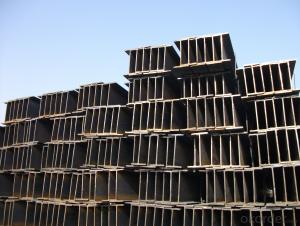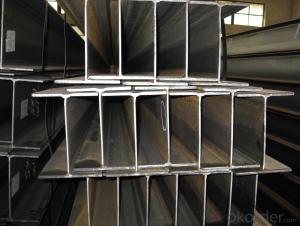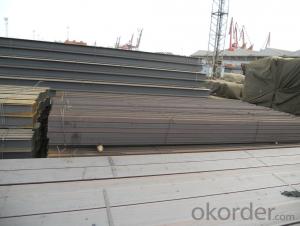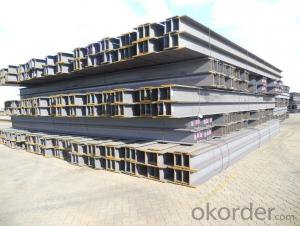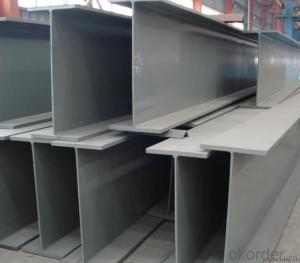Structural Steel Hot Rolled H-Beam High Quality
- Loading Port:
- China Main Port
- Payment Terms:
- TT or LC
- Min Order Qty:
- -
- Supply Capability:
- -
OKorder Service Pledge
OKorder Financial Service
You Might Also Like
Product Description:
OKorder is offering high quality Hot Rolled Steel I-Beams at great prices with worldwide shipping. Our supplier is a world-class manufacturer of steel, with our products utilized the world over. OKorder annually supplies products to European, North American and Asian markets. We provide quotations within 24 hours of receiving an inquiry and guarantee competitive prices.
Product Applications:
Hot Rolled Steel I-Beams are ideal for structural applications and are widely used in the construction of buildings and bridges, and the manufacturing, petrochemical, and transportation industries.
Product Advantages:
OKorder's Steel I-Beams are durable, strong, and resist corrosion.
Main Product Features:
· Premium quality
· Prompt delivery & seaworthy packing (30 days after receiving deposit)
· Corrosion resistance
· Can be recycled and reused
· Mill test certification
· Professional Service
· Competitive pricing
Product Specifications:
Manufacture: Hot rolled
Grade: Q195 – 235
Certificates: ISO, SGS, BV, CIQ
Length: 6m – 12m, as per customer request
Packaging: Export packing, nude packing, bundled
SIZE(mm) | DIMENSION(kg/m) |
100*100 | 16.9 |
125*125 | 23.6 |
150*75 | 14 |
150*150 | 31.1 |
148*100 | 20.7 |
198*99 | 17.8 |
200*100 | 20.9 |
248*124 | 25.1 |
250*125 | 29 |
Payment:
-Invoicing on theoretical weight or actual weight as customer’s request.
-FOB, CFR or CIF.
-Regular terms of payment:
1, 30% payment in advance, the remaining balance (70% payment) against the copy of B/L.
2, 30% payment in advance, the remaining balance (70% L/C) against the copy of B/L.
3, Negotiable.
-The payment terms will be written in contraction detailed.
FAQ:
Q1: Why buy Materials & Equipment from OKorder.com?
A1: All products offered byOKorder.com are carefully selected from China's most reliable manufacturing enterprises. Through its ISO certifications, OKorder.com adheres to the highest standards and a commitment to supply chain safety and customer satisfaction.
Q2: How do we guarantee the quality of our products?
A2: We have established an advanced quality management system which conducts strict quality tests at every step, from raw materials to the final product. At the same time, we provide extensive follow-up service assurances as required.
Q3: How soon can we receive the product after purchase?
A3: Within three days of placing an order, we will begin production. The specific shipping date is dependent upon international and government factors, but is typically 7 to 10 workdays.
Images:
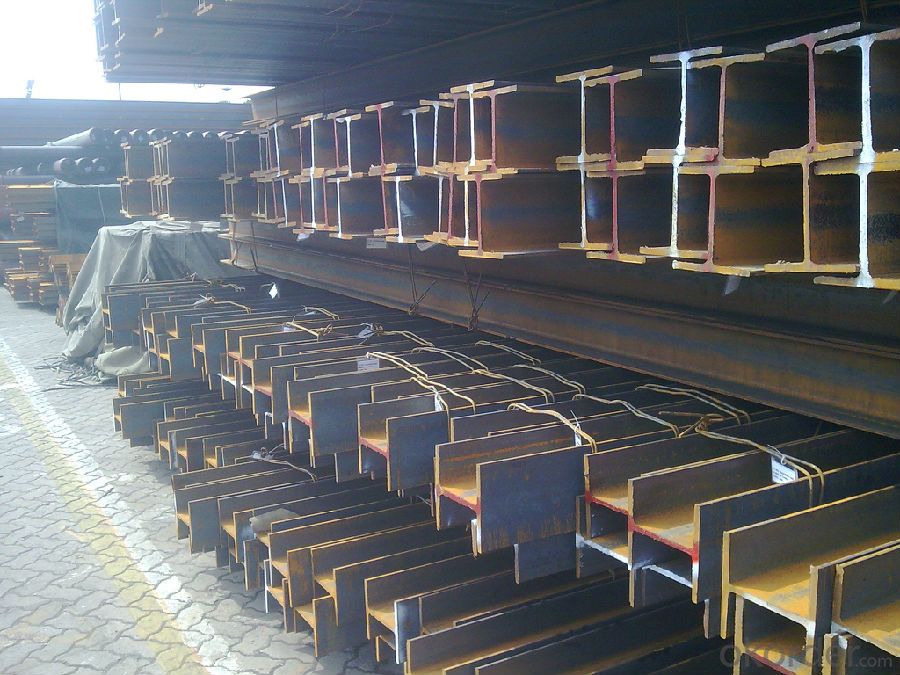
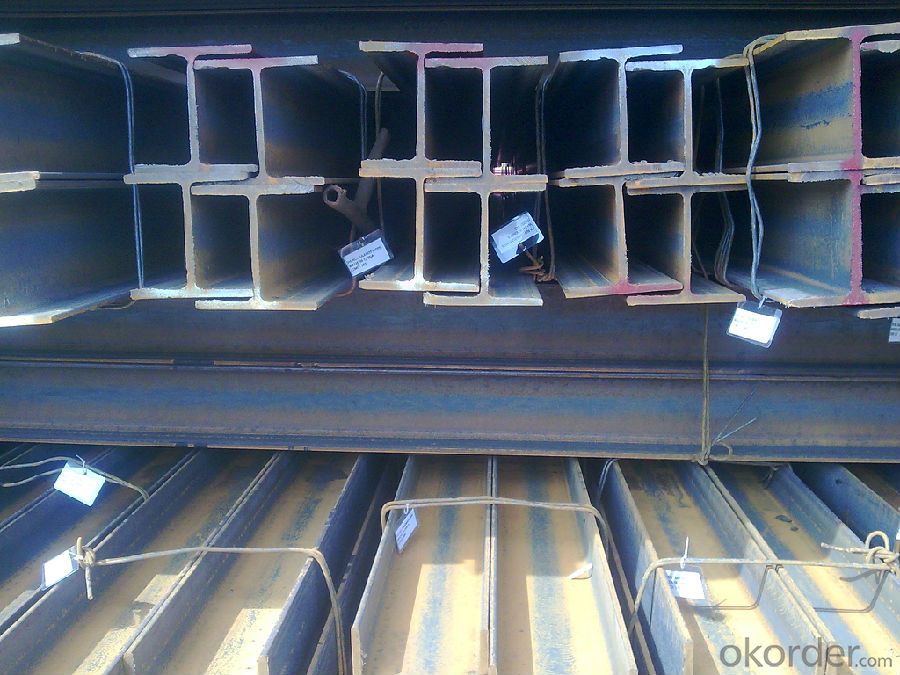
- Q:How do Steel H-Beams contribute to the overall architectural design of a structure?
- Steel H-beams are an essential component in the architectural design of a structure as they provide crucial support and stability. These beams are specifically designed to bear heavy loads and distribute weight efficiently, making them ideal for constructing large-scale structures such as buildings, bridges, and industrial facilities. One of the primary contributions of steel H-beams to the overall architectural design is their ability to span long distances without the need for additional support columns or walls. This feature allows architects to design open and flexible floor plans, maximizing the usable space within a structure. The absence of intermediate columns not only enhances the aesthetic appeal but also provides freedom in creating large, uninterrupted spaces. In addition to their functional benefits, steel H-beams also offer aesthetic advantages to the architectural design. They provide a sleek and modern appearance, with their clean lines and minimalistic design. This visual appeal makes them a popular choice for contemporary and industrial-style structures, adding an element of sophistication and elegance to the overall design. Moreover, steel H-beams are incredibly versatile in terms of their adaptability to various architectural styles. They can be easily integrated into different designs, whether it be a traditional or modern structure. The flexibility of these beams allows architects to create unique and innovative designs that meet both the functional and aesthetic requirements of a project. Furthermore, steel H-beams contribute to the overall architectural design by providing structural integrity and durability. The high-strength steel used in their construction ensures that the structure can withstand heavy loads, environmental forces, and natural disasters. This durability not only ensures the safety of occupants but also minimizes maintenance and repair costs over time. In conclusion, steel H-beams play a crucial role in the architectural design of a structure by providing support, stability, and flexibility. They enable the creation of open and spacious interiors, add a modern and sophisticated touch to the design, and ensure structural integrity and durability. Whether it is for a commercial building, a residential project, or an industrial facility, steel H-beams are an indispensable element that contributes to the overall success and functionality of the architectural design.
- Q:What are the different methods of installing steel H-beams?
- Installing steel H-beams can be done using various methods, depending on the project requirements and available resources. Below are some commonly used techniques: 1. The first method involves the use of heavy machinery like cranes or forklifts to lift and position the steel H-beams. This approach is typically employed for larger structures or when installing beams at significant heights. 2. Welding is another common technique used to connect steel H-beams either to each other or to other structural elements. It requires melting and fusing the metal to create a strong joint. Welding can be carried out on-site or in a fabrication shop, depending on the project's needs. 3. Bolting is a method where bolts and nuts are used to secure the steel H-beams together or to other structural components. Bolting is often favored in situations where future disassembly or modifications may be necessary. 4. Concrete embedment is employed when additional stability and support are required. Steel H-beams are embedded in concrete by creating holes in the concrete structure and placing the beams into them. The beams are then held in place as the concrete sets. 5. Steel plates and brackets can also be utilized to connect steel H-beams to other structural elements. These plates are typically attached to the beams through bolting or welding and then affixed to the desired location. It is crucial to consider factors such as project requirements, structural design, and available resources when choosing the appropriate method for installing steel H-beams. Seeking advice from a structural engineer or construction professional is highly recommended for determining the most suitable installation approach for a specific project.
- Q:What are the common safety precautions when working with steel H-beams?
- When working with steel H-beams, there are several common safety precautions that should be followed to ensure a safe working environment. These precautions include: 1. Personal Protective Equipment (PPE): It is essential to wear the appropriate PPE, such as a hard hat, safety glasses, gloves, and steel-toed boots, to protect against potential hazards. Additionally, high-visibility clothing should be worn to increase visibility and prevent accidents. 2. Proper Lifting Techniques: Steel H-beams can be heavy and cumbersome, so it is crucial to use correct lifting techniques to avoid strain or injury. This includes bending the knees, keeping the back straight, and using the legs to lift rather than relying on the back or arms. 3. Secure Storage and Handling: When not in use, steel H-beams should be stored in a secure and designated area to prevent them from falling or causing a hazard. When handling the beams, it is important to use lifting equipment, such as cranes or forklifts, to ensure safe transportation. 4. Safe Working Area: The work area should be clear of any debris, tools, or other obstacles that may pose a tripping or falling hazard. It is also essential to mark the area with caution signs or barriers to prevent unauthorized personnel from entering the work zone. 5. Proper Training and Supervision: Workers should receive adequate training on the safe handling and use of steel H-beams. Supervisors should ensure that workers are following safety protocols and provide guidance or assistance if needed. 6. Inspection and Maintenance: Regular inspection of steel H-beams is necessary to identify any signs of damage, such as cracks or corrosion, which could compromise their structural integrity. Damaged beams should be replaced immediately to prevent accidents. 7. Communication and Signaling: Clear communication and signaling among workers is vital when working with steel H-beams. This includes using hand signals or radios to relay instructions or warnings, especially in noisy or busy construction sites. By following these common safety precautions, the risk of accidents or injuries when working with steel H-beams can be significantly reduced, ensuring a safer work environment for all involved.
- Q:How do you calculate the shear stress in steel H-beams?
- To determine the shear stress in steel H-beams, one must ascertain the applied load and the cross-sectional area of the beam. The shear stress can then be calculated by dividing the applied load by the cross-sectional area. Initially, the cross-sectional area of the H-beam must be calculated. This can be accomplished by measuring the beam's dimensions, such as the flange width, flange thickness, web height, and web thickness. Subsequently, one can calculate the area of each component (flanges and web) and then add them together to obtain the total cross-sectional area. Subsequently, the applied load on the beam needs to be determined. This information can be obtained from the design specifications or the actual load imposed on the beam. Once the value of the applied load is known, it can be divided by the cross-sectional area of the beam to calculate the shear stress. It is important to note that shear stress is typically calculated under the assumption that the load is evenly distributed across the cross-section of the beam. If the load is not uniformly distributed or if additional factors such as bending moments are present, a more comprehensive analysis may be required. In conclusion, the calculation of shear stress in steel H-beams necessitates the determination of the cross-sectional area and the division of the applied load by this area. This calculation provides insights into the shear stress experienced by the beam and aids in the evaluation of its structural integrity.
- Q:H steel column calculationHow do you calculate the amount? And what are the steps and formulas for this calculation?
- H steel is welded; HWHMHN is the hot rolled HW H steel is the height and width of flange is basically the same; mainly used for reinforced concrete frame column steel column, also known as rigid steel column; in steel structure is mainly used for HM H type steel column height and wing
- Q:Are steel H-beams suitable for automotive assembly plants?
- Yes, steel H-beams are suitable for automotive assembly plants. They are commonly used in the construction of industrial buildings, including automotive assembly plants, due to their strength, durability, and ability to withstand heavy loads. Steel H-beams provide structural support, allowing for the creation of large open spaces and efficient assembly line layouts.
- Q:What are the standard lengths of steel H-beams?
- The standard lengths of steel H-beams can vary depending on the manufacturer and specific product specifications. However, in general, steel H-beams are often available in standard lengths ranging from 20 feet to 65 feet. These lengths are commonly used in construction and structural engineering applications, as they provide sufficient support and stability for various building projects. Additionally, some manufacturers may offer customized lengths based on specific customer requirements. It is always recommended to consult with the manufacturer or supplier to determine the exact standard lengths available for a particular steel H-beam product.
- Q:Can steel H-beams be used in data center or server room construction?
- Yes, steel H-beams can be used in data center or server room construction. Steel H-beams are commonly used as structural support in construction projects due to their high strength and durability. In data center or server room construction, where stability and load-bearing capacity are crucial, steel H-beams can provide the necessary strength to support heavy equipment and infrastructure.
- Q:What are the differences between hot-rolled and cold-formed steel H-beams?
- Hot-rolled and cold-formed steel H-beams are two commonly used structural steel products that have distinct differences in their manufacturing processes and properties. Firstly, the manufacturing process for hot-rolled H-beams involves heating a steel billet or slab above its recrystallization temperature and then passing it through a series of rollers to shape it into the desired H-beam profile. This process results in a finished product with a rough surface texture and a scaled outer layer. In contrast, cold-formed H-beams are produced by bending and shaping steel sheets or strips at room temperature, typically through a series of rollers or press brakes. This method produces a smoother surface finish and eliminates the need for scaling. In terms of their properties, hot-rolled H-beams tend to have higher strength and load-bearing capacity compared to cold-formed H-beams. This is due to the structural changes that occur during the hot-rolling process, which refine the grain structure of the steel and increase its overall toughness. Cold-formed H-beams, on the other hand, have a higher degree of dimensional accuracy and consistency due to the precise shaping and bending process. This makes them suitable for applications where precise measurements and tight tolerances are required. Another significant difference lies in their cost and availability. Hot-rolled H-beams are generally more readily available and cost-effective compared to cold-formed H-beams. The hot-rolling process is faster and more efficient, allowing for larger production volumes and lower production costs. Cold-formed H-beams, on the other hand, may require additional processing and fabrication steps, which can increase their overall cost. In summary, the main differences between hot-rolled and cold-formed steel H-beams lie in their manufacturing processes, surface finish, properties, and cost. Hot-rolled H-beams offer higher strength and load-bearing capacity, while cold-formed H-beams provide greater dimensional accuracy and consistency. The choice between the two depends on the specific requirements of the project, including budget, structural needs, and aesthetic considerations.
- Q:Can steel H-beams be used in historical or heritage building restoration?
- Yes, steel H-beams can be used in historical or heritage building restoration. In fact, steel H-beams are often preferred in restoration projects due to their strength, durability, and versatility. These beams can provide structural support to weakened or damaged areas of a building, helping to ensure its stability and longevity. Additionally, steel H-beams can be customized and fabricated to match the original architectural features of the building, allowing for a seamless integration with the existing structure. Despite being a modern material, steel H-beams can be designed to mimic traditional construction methods, preserving the historical integrity of the building while providing the necessary reinforcement. Therefore, steel H-beams are a viable option for restoring historical or heritage buildings.
1. Manufacturer Overview |
|
|---|---|
| Location | |
| Year Established | |
| Annual Output Value | |
| Main Markets | |
| Company Certifications | |
2. Manufacturer Certificates |
|
|---|---|
| a) Certification Name | |
| Range | |
| Reference | |
| Validity Period | |
3. Manufacturer Capability |
|
|---|---|
| a)Trade Capacity | |
| Nearest Port | |
| Export Percentage | |
| No.of Employees in Trade Department | |
| Language Spoken: | |
| b)Factory Information | |
| Factory Size: | |
| No. of Production Lines | |
| Contract Manufacturing | |
| Product Price Range | |
Send your message to us
Structural Steel Hot Rolled H-Beam High Quality
- Loading Port:
- China Main Port
- Payment Terms:
- TT or LC
- Min Order Qty:
- -
- Supply Capability:
- -
OKorder Service Pledge
OKorder Financial Service
Similar products
New products
Hot products
Related keywords
